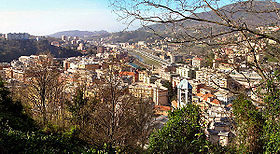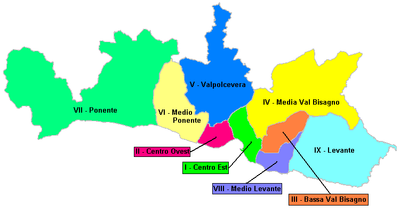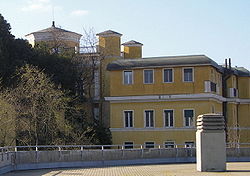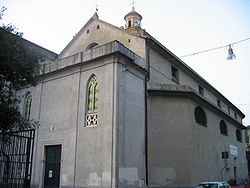
Bolzaneto
Encyclopedia


Genoa
Genoa |Ligurian]] Zena ; Latin and, archaically, English Genua) is a city and an important seaport in northern Italy, the capital of the Province of Genoa and of the region of Liguria....
, in northwest Italy
Italy
Italy , officially the Italian Republic languages]] under the European Charter for Regional or Minority Languages. In each of these, Italy's official name is as follows:;;;;;;;;), is a unitary parliamentary republic in South-Central Europe. To the north it borders France, Switzerland, Austria and...
, and is part of the Municipality Valpolcevera of Genoa.
Geography
Bolzaneto was once a hamlet located outside of the city limits in the Polcevera valley, but in the recent centuries it became an industrial area. Today it is a suburb of Genoa, surrounded by many small industries and business firms, but offering excellent views of the city and harbor. The Bolzaneto district includes the hamlets of Morego, San Biagio, Brasile, Cremeno, Geminiano and Murta. The district has a population of 15,239 inhabitants (as of December 31, 2006).On the mountains behind Bolzaneto, at the left side of Polcevera valley, are two fortresses, which are part of the external fortresses of Genoa: the “Fort Diamante” and the fort named “Fratello Minore”. At the right side of valley, on Mount Figogna (804 m), is the Shrine of N.S. della Guardia, from where you have a wide view of the valley. The Shrine, located in the municipality of Ceranesi
Ceranesi
Ceranesi is a comune in the Province of Genoa in the Italian region Liguria, located about 11 km northwest of Genoa.The Municipality of Ceranesi includes also the Shrine of N.S. della Guardia, the most important Marian shrine in Liguria.Ceranesi borders the following municipalities: Bosio,...
can be reached by the provincial road No 52.
History
Until the mid-19th century Bolzaneto was a small village on the left side of the river Polcevera, near a wide bend of this. At the beginning of the second millennium the village was a simple group of houses around the church of N.S. della Neve (Our Lady of Snow). The town had been subject to the civil and religious authority of Brasile until 1854, when the municipal headquarters and the parish were transferred to Bolzaneto.Brasile is now a little hamlet on the hill behind Bolzaneto, but in the Middle Ages
Middle Ages
The Middle Ages is a periodization of European history from the 5th century to the 15th century. The Middle Ages follows the fall of the Western Roman Empire in 476 and precedes the Early Modern Era. It is the middle period of a three-period division of Western history: Classic, Medieval and Modern...
people lived there who had important roles in the government of the Republic of Genoa
Republic of Genoa
The Most Serene Republic of Genoa |Ligurian]]: Repúbrica de Zêna) was an independent state from 1005 to 1797 in Liguria on the northwestern Italian coast, as well as Corsica from 1347 to 1768, and numerous other territories throughout the Mediterranean....
. Near Bolzaneto, then on the right side of Polcevera stream, was located the monastery of San Francesco alla Chiappetta, built at the end of the 13th century.
In the 18th century, the Republic of Genoa
Republic of Genoa
The Most Serene Republic of Genoa |Ligurian]]: Repúbrica de Zêna) was an independent state from 1005 to 1797 in Liguria on the northwestern Italian coast, as well as Corsica from 1347 to 1768, and numerous other territories throughout the Mediterranean....
, allied to France
France
The French Republic , The French Republic , The French Republic , (commonly known as France , is a unitary semi-presidential republic in Western Europe with several overseas territories and islands located on other continents and in the Indian, Pacific, and Atlantic oceans. Metropolitan France...
, was involved in War of Austrian Succession. In 1746 the valley, Valpolcevera, was occupied by an Austrian-Piedmontese army, led by the General Botta Adorno
Antoniotto Botta Adorno
thumb|Antoniotto Botta Adorno.Antoniotto Botta Adorno was a high officer of the Habsburg Monarchy and a plenipotentiary of the Austrian Netherlands.-Biography:...
, which came up to Genoa, from where he was expelled after the popular revolt of December 5, 1746, set up with the legendary episode of Balilla.
Starting on April 11, 1747 another Austrian army Siege of Genoa (1747)
Siege of Genoa (1747)
The Siege of Genoa took place in 1747 when an Austrian army under the command of Count Schulenberg launched a failed attempt to capture the capital of the Republic of Genoa....
unsuccessfully besieged Genoa. The Austrians, coming from the North through the Apennine
Apennine
-Other places on Earth:*The Apennine or Italian peninsula*Apennins, a department of the first French Empire-Plants and animals:*The Apennine , a modern breed of domestic sheep.*Apennine Shrew, an insectivore endemic to Italy...
, again occupied the whole Valpolcevera. The prolonged occupation led to looting and desctruction of the homes and villages in the region. In the weeks that followed, an army of volunteers of Valpolcevera, supported by regular troops of the Republic of Genoa began a counter-offensive, forcing the evacuation on July 9, 1747 from the Valpocevera of the Austrian army, leaving behind much of the area in a state of devastation.
The topography of the place had a great change in the mid-19th century, when the Genoa-Turin railway was built. It was necessary to correct and dam the frequently-flooding Polcevera river, eliminating the existing bend. A new path for the torrent bed was dug for about 500 m, by cutting the base of the Murta hill upstream the monastery of San Francesco (that so passed from right to left bank of the stream) and an embankment on the left side was built, on which the railway runs.
Gradually many houses were built up in the old stream-bed, thus forming the present town of Bolzaneto.
In the second half of the 19th century, the area, formerly agricultural, became industrial, with the establishment of several companies (the most important were the Foundries Bruzzo and the soap factory Lo Faro). In 1926, together with other 18 municipalities, Bolzaneto joined the municipality of Genoa, to form the so called Great Genoa.
After the Second World War, the steel crisis led to the closure of Foundries Bruzzo (1957) and in a portion of these areas, near S. Biagio, was built the ERG refinery (then closed in 1988, also as a result of the growing attention of people to environmental aspects). In this area where there is now a large shopping center and a new residential district. Like this, other areas, abandoned since 1960, due to the closure of factories, many small industries and businesses firms have now replaced them.
Close to Bolzaneto there is a police barracks
Barracks
Barracks are specialised buildings for permanent military accommodation; the word may apply to separate housing blocks or to complete complexes. Their main object is to separate soldiers from the civilian population and reinforce discipline, training and esprit de corps. They were sometimes called...
that in 2001 was in the international headlines, when there many protesters (arrested during the disturbances occurred at the G8 meeting in the city of Genoa
27th G8 summit
-Overview:The Group of Seven was an unofficial forum which brought together the heads of the richest industrialized countries: France, Germany, Italy, Japan, the United Kingdom, the United States and Canada starting in 1976. The G8, meeting for the first time in 1997, was formed with the addition...
) were imprisoned. Some police officer
Police officer
A police officer is a warranted employee of a police force...
s were accused and convicted of organised brutality on a large scale.
Since 2005, the quarter of Morego is home to the headquarters of the Italian Institute of Technology
Italian Institute of Technology
The Istituto Italiano di Tecnologia or Italian Institute of Technology is a foundation established jointly by the Italian Ministry of Education, Universities and Research and the Ministry of Economy and Finance to promote excellence in basic and applied research and to contribute to the economic...
(IIT).
Castle of Bolzaneto

Castle
A castle is a type of fortified structure built in Europe and the Middle East during the Middle Ages by European nobility. Scholars debate the scope of the word castle, but usually consider it to be the private fortified residence of a lord or noble...
was a fortress built by the noble Genoese family of Adorno
Adorno (family)
The Adorno family was a patrician family in Genoa, Italy, of the Ghibelline party, several of whom were Doges of the republic. The first of these, Gabriele Adorno, is also the tenor role in Giuseppe Verdi's opera Simon Boccanegra....
. It was destroyed in the 14th century by the mercenary troops of the Visconti
House of Visconti
Visconti is the family name of two important Italian noble dynasties of the Middle Ages. There are two distinct Visconti families: The first one in the Republic of Pisa in the mid twelfth century who achieved prominence first in Pisa, then in Sardinia where they became rulers of Gallura...
, being rebuilt by the Republic of Genoa
Republic of Genoa
The Most Serene Republic of Genoa |Ligurian]]: Repúbrica de Zêna) was an independent state from 1005 to 1797 in Liguria on the northwestern Italian coast, as well as Corsica from 1347 to 1768, and numerous other territories throughout the Mediterranean....
in 1380. The castle was also participated in the fighting of 1746-1747 during the War of Austrian Succession, and also became the headquarters of the Podestà (major) of Polcevera Valley. At the beginning of the 20th century it was abandoned as military stronghold and transformed into a residential villa, then into a hospital, until 1990. Currently it is used as a home for the elderly and hospice.
Fortresses
The Fortresses called "I Due Fratelli" (The Two Brothers) were two fortresses said, referring to their position, "Major Brother" and "Minor Brother". They were built by the SavoyHouse of Savoy
The House of Savoy was formed in the early 11th century in the historical Savoy region. Through gradual expansion, it grew from ruling a small county in that region to eventually rule the Kingdom of Italy from 1861 until the end of World War II, king of Croatia and King of Armenia...
in the first half of nineteenth century, after the annexation of the Republic of Genoa
Republic of Genoa
The Most Serene Republic of Genoa |Ligurian]]: Repúbrica de Zêna) was an independent state from 1005 to 1797 in Liguria on the northwestern Italian coast, as well as Corsica from 1347 to 1768, and numerous other territories throughout the Mediterranean....
to Kingdom of Sardinia
Kingdom of Sardinia
The Kingdom of Sardinia consisted of the island of Sardinia first as a part of the Crown of Aragon and subsequently the Spanish Empire , and second as a part of the composite state of the House of Savoy . Its capital was originally Cagliari, in the south of the island, and later Turin, on the...
, established by Congress of Vienna
Congress of Vienna
The Congress of Vienna was a conference of ambassadors of European states chaired by Klemens Wenzel von Metternich, and held in Vienna from September, 1814 to June, 1815. The objective of the Congress was to settle the many issues arising from the French Revolutionary Wars, the Napoleonic Wars,...
in 1814. The first fortress, shaped as a simple tower, was demolished in 1932 to create an antiaircraft position, the second one (Minor Brother) is still intact and overlooks the valley from the top of Mount Spino (622 m). The "Fort Diamante", on the top of mount bearing the same name, has been built in the 18th century, then completed and modified in the first half of the 19th century.
Villas and palaces
In Bolzaneto and on Murta hill there were, in the past centuries, many villas and palaces used as summer residences by the noble and rich Genoese families. Some of these survived today, although now surrounded by factories and sheds.These buildings, restructured, are used as schools, offices or private houses.
Among these Villa Carrega (17th century) and Villa Garibaldi (now both used as nursery schools) and, on the right bank of Polcevera the Palaces Rivarola and Pareto. Near the hamlet of Cremeno is the Villa Cambiaso, which was the summer residence of Giovanni Battista Cambiaso, who was Doge
Doge of Genoa
The Republic of Genoa, in what is now northern Italy, was technically a communal republic in the early Middle Ages, although it was actually an oligarchy ruled by a small group of merchant families, from whom were selected the Doges of Genoa.- History :...
of the Republic of Genoa
Republic of Genoa
The Most Serene Republic of Genoa |Ligurian]]: Repúbrica de Zêna) was an independent state from 1005 to 1797 in Liguria on the northwestern Italian coast, as well as Corsica from 1347 to 1768, and numerous other territories throughout the Mediterranean....
(from 1771 to 1773).

Church of N.S. della Neve
The first Church of N.S. della Neve was built in the 14th century as a chapel depending by the parish of San Felice of Brasile, restored in seventeenth century and completely rebuilt in 1855 when became the seat of the parish.In 1956 a new modern church, consecrated by Cardinal Giuseppe Siri in 1960, was built in another site nearby and the old church was demolished.
In this new church has been placed the Baroque
Baroque
The Baroque is a period and the style that used exaggerated motion and clear, easily interpreted detail to produce drama, tension, exuberance, and grandeur in sculpture, painting, literature, dance, and music...
altars and statues of the old church. In the church there are also two paintings by Paolo Gerolamo Piola (Conversion of Saint Paul
Paul of Tarsus
Paul the Apostle , also known as Saul of Tarsus, is described in the Christian New Testament as one of the most influential early Christian missionaries, with the writings ascribed to him by the church forming a considerable portion of the New Testament...
and Abraham
Abraham
Abraham , whose birth name was Abram, is the eponym of the Abrahamic religions, among which are Judaism, Christianity and Islam...
receives three angels) and a Dead Jesus by Giulio Cesare Procaccini
Giulio Cesare Procaccini
Giulio Cesare Procaccini was an Italian painter and sculptor of the early Baroque era in Milan.-Biography:Born in Bologna he was son of the Mannerist painter Ercole Procaccini the Elder and brother of Camillo Procaccini and Carlo Antonio Procaccini...
.
Church and Monastery of San Francesco alla Chiappetta

Monastery
Monastery denotes the building, or complex of buildings, that houses a room reserved for prayer as well as the domestic quarters and workplace of monastics, whether monks or nuns, and whether living in community or alone .Monasteries may vary greatly in size – a small dwelling accommodating only...
of San Francesco was given by the noble family Lercari to St. Francis of Assisi
Francis of Assisi
Saint Francis of Assisi was an Italian Catholic friar and preacher. He founded the men's Franciscan Order, the women’s Order of St. Clare, and the lay Third Order of Saint Francis. St...
, who was in Genoa
Genoa
Genoa |Ligurian]] Zena ; Latin and, archaically, English Genua) is a city and an important seaport in northern Italy, the capital of the Province of Genoa and of the region of Liguria....
in 1213 during a trip to France
France
The French Republic , The French Republic , The French Republic , (commonly known as France , is a unitary semi-presidential republic in Western Europe with several overseas territories and islands located on other continents and in the Indian, Pacific, and Atlantic oceans. Metropolitan France...
, but there are no documents that attest that.
The donation of the land is documented by a Convention act for the building of the monastery and the church of Chiappetta, stipulated in the 1280 between the family Lercari and the Franciscan Order, implemented in 1291.
In the following years the monastery and the church were built, in primitive Gothic
Gothic architecture
Gothic architecture is a style of architecture that flourished during the high and late medieval period. It evolved from Romanesque architecture and was succeeded by Renaissance architecture....
style.
In the second half of 17th century the cloister
Cloister
A cloister is a rectangular open space surrounded by covered walks or open galleries, with open arcades on the inner side, running along the walls of buildings and forming a quadrangle or garth...
was built on and at the beginning of eighteenth century the church and the monastery had been completely restructured.
The inside of the church was remaked in Baroque
Baroque
The Baroque is a period and the style that used exaggerated motion and clear, easily interpreted detail to produce drama, tension, exuberance, and grandeur in sculpture, painting, literature, dance, and music...
(style) by the Lombard architect Francesco Muttoni (1668 - 1747).
Inside the church, which has a single nave
Nave
In Romanesque and Gothic Christian abbey, cathedral basilica and church architecture, the nave is the central approach to the high altar, the main body of the church. "Nave" was probably suggested by the keel shape of its vaulting...
, there are some remarkable paintings from the 17th century: Stigmata of St. Francis by Giovanni Battista Carlone
Giovanni Battista Carlone
Giovanni Battista Carlone was an Italian painter of the Baroque period, active mainly in Genoa.Carlone was born and died in Genoa. He came from a family of artists: his father Taddeo was a sculptor and his older brother Giovanni Bernardo Carlone, a well-trained painter. He may have had some...
, Assumption of the Blessed Virgin Mary by Pietro Paolo Raggi
Pietro Paolo Raggi
Pietro Paolo Raggi was an Italian painter of the Baroque period, active mainly in Northern Italy.Born in Genova, he received his first training in Venice, then came back to Genoa....
(1649-1724), St. Catherine Fieschi’s Ecstasy and Immaculate Conception by Domenico Piola
Domenico Piola
Domenico Piola was a Genoese painter of the Baroque period. His family studio was highly prolific.-Biography:Piola was an Italian painter, draughtsman, printmaker and designer...
and St. Anthony’s Miracle” by Giuseppe Galeotti.
There is also a wooden Madonna
Madonna (art)
Images of the Madonna and the Madonna and Child or Virgin and Child are pictorial or sculptured representations of Mary, Mother of Jesus, either alone, or more frequently, with the infant Jesus. These images are central icons of Roman Catholicism and Eastern Orthodox Christianity where Mary remains...
by Anton Maria Maragliano
Anton Maria Maragliano
Anton Maria Maragliano was an Italian sculptor of the Baroque period, known primarily for his wooden statues...
(1664-1741).
In 1798, due to Napoleon suppression of religious orders, the Franciscan friars had to leave the monastery and the church was entrusted to the diocesan clergy until 1896, when they could return.
As mentioned above, the monastery and the church, due to the work to embank the torrent Polcevera (middle of the 19th century), passed from the right to the left bank of the stream.
Roads
Bolzaneto is crossed by the National Road 35 “dei Giovi”, and the HighwayHighway
A highway is any public road. In American English, the term is common and almost always designates major roads. In British English, the term designates any road open to the public. Any interconnected set of highways can be variously referred to as a "highway system", a "highway network", or a...
A7 Genoa
Genoa
Genoa |Ligurian]] Zena ; Latin and, archaically, English Genua) is a city and an important seaport in northern Italy, the capital of the Province of Genoa and of the region of Liguria....
- Milan
Milan
Milan is the second-largest city in Italy and the capital city of the region of Lombardy and of the province of Milan. The city proper has a population of about 1.3 million, while its urban area, roughly coinciding with its administrative province and the bordering Province of Monza and Brianza ,...
, of which there is an important toll exit.
From Bolzaneto begin several provincial roads that leads to towns in the hinterland (Ceranesi
Ceranesi
Ceranesi is a comune in the Province of Genoa in the Italian region Liguria, located about 11 km northwest of Genoa.The Municipality of Ceranesi includes also the Shrine of N.S. della Guardia, the most important Marian shrine in Liguria.Ceranesi borders the following municipalities: Bosio,...
, Sant'Olcese
Sant'Olcese
Sant'Olcese is a comune in the Province of Genoa in the Italian region of Liguria, located about 6 km north of Genoa. As of 31 December 2004, it had a population of 5,945 and an area of 21.9 km²....
and Serra Riccò
Serra Riccò
Serra Riccò is a comune in the Province of Genoa in the Italian region Liguria, located about 9 km north of Genoa, in the Val Polcevera....
).
Railways
Bolzaneto has a railway station on the line of Giovi (Genoa-SampierdarenaSampierdarena
Sampierdarena is a major port and industrial area of Genoa, in northwest Italy. With San Teodoro it forms the West Central municipio.-Geography:...
, Bolzaneto, Pontedecimo, Busalla
Busalla
Busalla is a comune in the Province of Genoa in the Italian region Liguria, located about 27 km north of Genoa.Its territory is crossed by the upper valley of the Scrivia river. Nearby is the artificial Lake Busalletta....
, Ronco Scrivia
Ronco Scrivia
Ronco Scrivia is a comune in the Province of Genoa in the Italian region Liguria, located about 20 km north of Genoa. As of 31 December 2004, it had a population of 4,380 and an area of 30.5 km²....
). This line is covered only by regional trains from Genoa
Genoa
Genoa |Ligurian]] Zena ; Latin and, archaically, English Genua) is a city and an important seaport in northern Italy, the capital of the Province of Genoa and of the region of Liguria....
to Busalla
Busalla
Busalla is a comune in the Province of Genoa in the Italian region Liguria, located about 27 km north of Genoa.Its territory is crossed by the upper valley of the Scrivia river. Nearby is the artificial Lake Busalletta....
, Arquata Scrivia
Arquata Scrivia
Arquata Scrivia is a comune in the Province of Alessandria in the Italian region Piedmont, located about 100 km southeast of Turin and about 35 km southeast of Alessandria....
, Novi Ligure
Novi Ligure
Novi Ligure is a town and comune north of Genoa, in the Piedmont region of the province of Alessandria of northwest Italy.The town produces food, iron, steel, and textiles. It is an important junction for both road and railroad....
, Alessandria
Alessandria
-Monuments:* The Citadel * The church of Santa Maria di Castello * The church of Santa Maria del Carmine * Palazzo Ghilini * Università del Piemonte Orientale-Museums:* The Marengo Battle Museum...
, and vice versa.
Intercity trains to and from Milan
Milan
Milan is the second-largest city in Italy and the capital city of the region of Lombardy and of the province of Milan. The city proper has a population of about 1.3 million, while its urban area, roughly coinciding with its administrative province and the bordering Province of Monza and Brianza ,...
and Turin
Turin
Turin is a city and major business and cultural centre in northern Italy, capital of the Piedmont region, located mainly on the left bank of the Po River and surrounded by the Alpine arch. The population of the city proper is 909,193 while the population of the urban area is estimated by Eurostat...
, are routed on the Giovi branch line, which crosses longitudinally Bolzaneto, parallel to the line of Giovi.
External links
- http://www.fortidigenova.com/ - Site about Genoa's Fortresses

